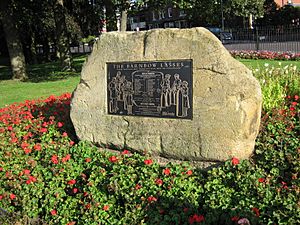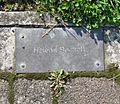Barnbow facts for kids
Barnbow was a small place near the city of Leeds in England. It's famous because of a huge munitions factory built there during the First World War. This factory was officially called National Filling Factory No. 1. Sadly, in 1916, a big explosion at the factory killed 35 women who worked there.
Contents
What Does Barnbow Mean?
The name Barnbow first appeared a long time ago, between 1185 and 1193. It comes from an old Viking (Old Norse) name, Bjarni, and the word bú, which means 'homestead' or 'estate'. So, the name originally meant 'Bjarni's homestead'. Later, people started to think the name included the word bow, which is why it looks like it does today.
Barnbow Munitions Factory
When the First World War started in August 1914, Britain suddenly needed a lot of weapons and ammunition. Shells were already being filled at another factory in Leeds. But even more factories were needed to make enough shells for the war.
A group of people decided to build a brand new munitions factory. They chose a spot called Barnbow, located between Cross Gates and Garforth. This factory became the most productive British shell factory during the First World War.
Special railway tracks were built right into the factory. This helped bring in materials and send out the finished shells. Long platforms were added at the nearby train station so thousands of workers could get to and from work. Huge factory buildings were quickly put up, and power lines were installed. The factory started filling shells in December 1915.
A large water pipe was also laid to bring in lots of water every day. Changing rooms and a canteen were built quickly too. The whole factory area covered about 200 acres (which is like 150 football fields!). Because it was a secret wartime factory, the newspapers weren't allowed to write about it.
Who Worked at Barnbow?
The factory needed a huge number of workers. An employment office was set up in Leeds to hire people. Many workers came from Leeds, but others traveled from places like York, Castleford, Wakefield, and nearby villages.
The factory ran 24 hours a day, six days a week, using a three-shift system. By October 1916, about 16,000 people worked at Barnbow! As the war went on, fewer men were available, so about 93% of the workers were women and girls. These women were lovingly called "The Barnbow Lasses."
Workers earned around £3 per week. However, women who handled explosives could earn more, sometimes £10-£12 per week, thanks to a bonus system. About 38 trains ran every day just to take workers to and from the factory.
Interestingly, one of the managers at the factory was Herbert Chapman. He later became a famous football manager for teams like Leeds City and Arsenal.
Working Conditions
Working conditions at Barnbow were very tough. Workers who handled explosives had to wear special clothes, like smocks and caps, and rubber-soled shoes. They even had to strip down to their underwear underneath these clothes for safety. Smoking and matches were completely forbidden.
The hours were long, and workers didn't get any holidays. Food was rationed, but they were allowed to drink as much barley water and milk as they wanted. This was important because of the chemicals they worked with. Barnbow even had its own farm with 120 cows to produce milk!
Many workers handled a chemical called Cordite. This chemical was used to propel shells, but it had a strange side effect: it turned people's skin yellow. Drinking lots of milk helped with this. Because of their yellow skin, many of the women were nicknamed The Barnbow Canaries. This nickname later inspired a play called Barnbow Canaries.
The Explosion
Just after 10 PM on Tuesday, December 5, 1916, hundreds of women and girls had just started their shift. They were filling, fusing, and packing four-and-a-half-inch shells. Room 42 was where the filling happened, and about 170 girls worked there. Shells arrived already loaded, and the workers just needed to add the fuse and screw on the cap.
At 10:27 PM, a huge explosion suddenly shook Room 42. It instantly killed 35 women and injured many more. Some of the dead could only be identified by the special identity discs they wore around their necks. The machine where the explosion happened was completely destroyed.
Even though it was still dangerous, many other workers rushed into Room 42 to help the injured and get them to safety.
Production at the factory stopped only for a short time. Once the bodies were removed, other girls bravely volunteered to work in Room 42. Many of the injured workers went away to recover.
Because of wartime censorship, the public was not told about the accident. However, a high-ranking military leader, Field Marshal Sir Douglas Haig, praised the workers who died. Many death notices in the local newspaper just said "killed by accident." This was the only hint of the tragedy.
Six years after the war ended, the public was finally told the full story of the Barnbow explosion.
There were two more explosions at the factory. One in March 1917 killed two girl workers, and another in May 1918 killed three men.
Barnbow was Britain's most important shell factory during the war. By the time the war ended on November 11, 1918, the factory had shipped out a massive 566,000 tons of ammunition.
ROF Leeds
During the Second World War, the factory became known as ROF Leeds. After that war, it even manufactured the Centurion tank.
Monuments
In October 2016, the site of the Barnbow Munitions Factory was recognized as a special historical monument.
There are two memorials in the area that list the names of all those who died. In Manston Park, there is a stone with a plaque. On Cross Gates Road, near a roundabout, there are three small stones with a simple message. Around them on the ground are metal tiles, each with the name of one of the women who died.
See also
- Filling factories in the United Kingdom






